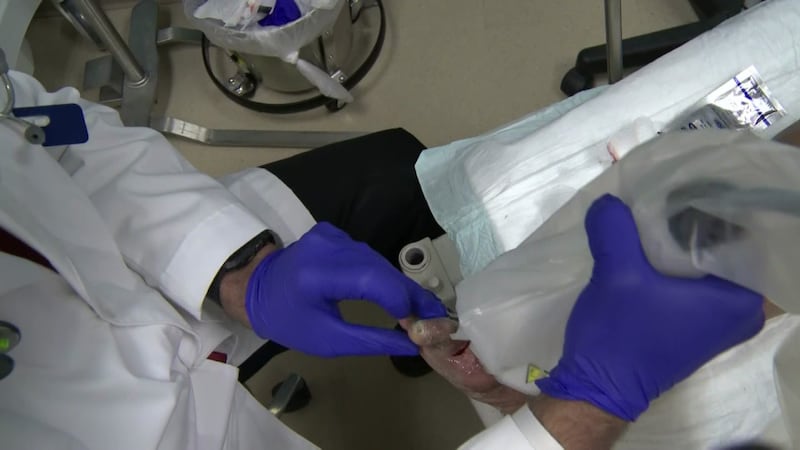DermaPACE: Quick treatment for diabetes wounds

Thousands of diabetics undergo amputation because wounds, mostly on feet and legs, just won't heal. Up until now, hyperbaric oxygen was the primary option, but it is expensive and time-consuming.
Now, there's a quick new shockwave treatment that acoustically stimulates deep tissue, helping to heal diabetic wounds.
"When he did that, I could feel it going into the skin," patient Mark Gomez said.
Gomez, a longtime diabetic, suffers from significant open wounds triggered by his battle with the disease.
"This is a good alternative for patients who are not healing," Northeast Baptist Wound Care Center Medical Director Dr. Jayesh B. Shah said. "You basically give 360 shocks for a minute, and it lasts two to four minutes, so it's not really complicated, it's pretty easy."
DermaPACE helps the body create new tissue and blood vessels caused by peripheral artery disease, a hallmark of diabetes. And according to longtime diabetic Jerry Fernandez, who has already had his first treatment, it's a quicker, faster alternative to the hyperbaric oxygen chamber.
"The new treatment that they have, it only lasts about five minutes total, for setups and all that," he said. "You go into the hyperbaric chamber and you will do it for two hours. They just kind of rub it around on your foot, and it's done."
For now, Shah is one of a handful of physicians nationwide clinically evaluating the dermaPACE.
"It's completely brand-new technology," Shah said. "It's kind of breakthrough compared to what we had so far in wound care."
DermaPACE is being evaluated in six states, and the cost per treatment has not been announced. The hyperbaric treatments run $500 to $1,000.
MEDICAL BREAKTHROUGHS
RESEARCH SUMMARY
TOPIC: DERMAPACE: QUICK TREATMENT FOR DIABETES WOUNDS
REPORT: MB #4585
BACKGROUND: Minor wounds, cuts, and burns are unfortunate but sometimes unavoidable. However, for people with diabetes, these injuries can lead to serious health issues. Many people with diabetes develop wounds that are slow to heal, do not heal well, or never heal. Sometimes, an infection might develop. Even when an infection does not develop in a wound, slow healing can adversely affect a person's overall health and quality of life. Cuts or injuries on the feet or legs can make walking difficult or exercise painful. It is essential that people who have diabetes keep their blood sugar levels under control to reduce the risk of slow-healing wounds and complications, including foot ulcers. (Source: https://www.medicalnewstoday.com/articles/320739.php)
PREVENTATIVE MEASURES: The best way to treat a diabetic foot ulcer is to prevent its development in the first place. Recommended guidelines include seeing a podiatrist on a regular basis. He or she can determine if you are at high risk for developing a foot ulcer and implement strategies for prevention. You are at high risk if you have neuropathy, have poor circulation, have a foot deformity (i.e. bunion, hammer toe), wear inappropriate shoes, or have uncontrolled blood sugar. Reducing additional risk factors, such as smoking, drinking alcohol, high cholesterol, and elevated blood glucose are important in the prevention and treatment of a diabetic foot ulcer. Wearing the appropriate shoes and socks will go a long way in reducing risks. Your podiatrist can provide guidance in selecting the proper shoes. (Source: https://www.podiatrists.org/visitors/foothealth/general/diabwound)
NEW TECHNOLOGY: There is a new option for patients who suffer from acute and chronic wounds. Jayesh B. Shah, MD, Medical Director from Northeast Baptist Wound Care Center said, "Right now we are doing a clinical evaluation of this new technique (dermaPACE) because it just got approved by FDA. It's acoustic shockwaves where you get shocks to the tissue around the wound to stimulate healing. Basically, it helps you with regeneration of the tissues. It helps you with new vascularization to create new blood vessels mainly in diabetic microvascular disease. It basically gives 360 shocks a minute. The treatment usually last two to four minutes and it's not really complicated. It's pretty easy." (Source: Jayesh B. Shah, MD)









